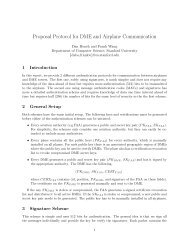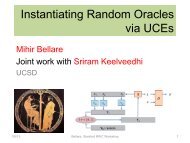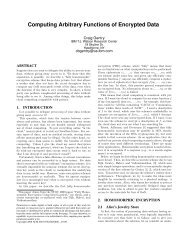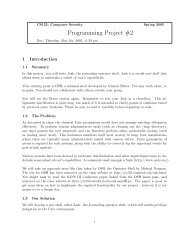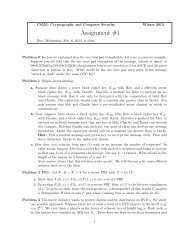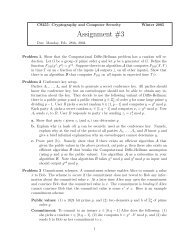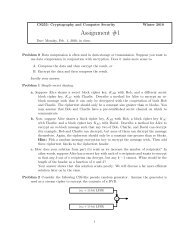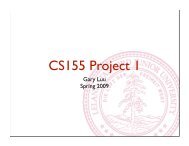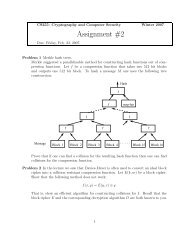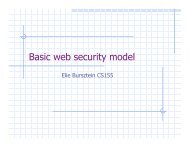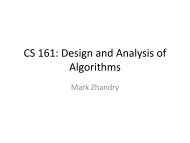Auditing SQL Queries - Stanford Crypto Group - Stanford University
Auditing SQL Queries - Stanford Crypto Group - Stanford University
Auditing SQL Queries - Stanford Crypto Group - Stanford University
Create successful ePaper yourself
Turn your PDF publications into a flip-book with our unique Google optimized e-Paper software.
We have only just scratched the surface of this connection so<br />
far, and for most definitions and query classes, the questions<br />
remains wide open.<br />
VIII. CONCLUSIONS<br />
In this paper we introduced a framework for auditing queries<br />
and several different notions of suspiciousness that differed in<br />
their disclosure detection guarantees as well as the tractability<br />
of auditing under them for different classes of queries. Out<br />
of all these the notion of weak syntactic suspiciousness had<br />
many positive qualities:<br />
• A weak syntactic auditor was designed for a large class<br />
of conjunctive queries that was polynomial in just the<br />
size of the query expressions.<br />
• The weak syntactic auditor in conjunction with a set of<br />
association views can be used to detect queries that potentially<br />
violated the association privacy of an individual<br />
and his sensitive attributes.<br />
• The weak syntactic auditor can be used in an online<br />
setting to deny queries and prevent violations of the<br />
association privacy of an individual.<br />
It would be interesting to explore other definitions of<br />
suspiciousness that lie in this space and their properties. In<br />
particular, a clear future direction would be to consider relaxations<br />
of weak syntactic suspiciousness that in conjunction<br />
with a set of association views permit bounded changes in an<br />
attacker’s posterior distribution over an individual’s sensitive<br />
attributes. This would be very useful in an online setting to<br />
avoid draconian denial policies. We also drew an interesting<br />
connection to the problem of checking query validity. Exploring<br />
this connection further is an avenue for further research.<br />
ACKNOWLEDGEMENTS<br />
We thank Dan Suciu, Gerome Miklau and Nilesh Dalvi for<br />
their help in understanding results from [8]. This work was<br />
supported in part by NSF Grant ITR-0331640, TRUST (NSF<br />
award number CCF-0424422), and a grant from Google. The<br />
second author was also supported in part by a <strong>Stanford</strong><br />
Graduate Fellowship from Sequoia Capital.<br />
REFERENCES<br />
[1] N. Adam and J. Wortmann. Security-control methods for statistical<br />
databases: a comparative study. ACM Computing Surveys, 21(4):515–<br />
556, 1989.<br />
[2] R. Agrawal, R. Bayardo, C. Faloutsos, J. Kieman, R. Rantzau, and<br />
R. Srikant. <strong>Auditing</strong> Compliance with a Hippocratic Database. In<br />
Proceedings of the International Conference on Very Large Databases<br />
(VLDB), 2004.<br />
[3] F. Chin. Security Problems on Inference Control for SUM, MAX, and<br />
MIN <strong>Queries</strong>. J. ACM, 33(3):451–464, 1986.<br />
[4] F. Y. Chin, P. Kossowski, and S. C. Loh. Efficient Inference Control<br />
for Range Sum <strong>Queries</strong>. Theoretical Computer Science, 32(1–2):77–86,<br />
July 1984.<br />
[5] D. Dobkin, A. Jones, and R. Lipton. Secure Databases: Protection<br />
against User Influence. ACM Transactions on Database Systems (TODS),<br />
4(1):97–106, 1979.<br />
[6] K. Kenthapadi, N. Mishra, and K. Nissim. Simulatable <strong>Auditing</strong>. In<br />
Proceedings of the ACM Symposium on Principles of Database Systems<br />
(PODS), pages 118–127, 2005.<br />
[7] A. Machanavajjhala and J. Gehrke. On the Efficiency of Checking<br />
Perfect Privacy. In Proceedings of the ACM Symposium on Principles<br />
of Database Systems (PODS), 2006.<br />
[8] G. Miklau and D. Suciu. A Formal Analysis of Information Disclosure<br />
in Data Exchange. Journal of Computer and System Sciences, 2006.<br />
[9] A. Motro. An Access Authorization Model for Relational Databases<br />
Based on Algebraic Manipulation of View Definitions. In Proceedings<br />
of the International Conference on Data Engineering (ICDE), 1989.<br />
[10] R. Motwani, S. U. Nabar, and D. Thomas. <strong>Auditing</strong> <strong>SQL</strong> <strong>Queries</strong>.<br />
http://dbpubs.stanford.edu/pub/2007-13, Technical Report, <strong>Stanford</strong> <strong>University</strong>,<br />
2007.<br />
[11] S. U. Nabar, B. Marthi, K. Kenthapadi, N. Mishra, and R. Motwani.<br />
Towards Robustness in Query <strong>Auditing</strong>. In Proceedings of the International<br />
Conference on Very Large Databases (VLDB), 2006.<br />
[12] S. Reiss. Security in Databases: A Combinatorial Study. J. ACM,<br />
26(1):45–57, 1979.<br />
[13] S. Rizvi, A. Medelzon, S. Sudarshan, and P. Roy. Extending Query<br />
Rewriting Techniques for Fine-Grained Access Control. In Proceedings<br />
of the ACM International Conference on Management of Data (SIG-<br />
MOD), 2004.<br />
[14] A. Rosenthal and E. Sciore. View Security as the Basis for Data<br />
Warehouse Security. In Proceedings of the International Workshop on<br />
Design and Management of Data Warehouses, 2000.<br />
[15] A. Rosenthal, E. Sciore, and V. Doshi. Security Administration for<br />
Federations, Warehouses, and other Derived Data. In Proceedings of<br />
the IFIP WG11.3 Conference on Database Security, 1999.<br />
[16] L. Sweeney. Uniqueness of simple demographics in the U.S. population.<br />
LIDAP-WP4. Carnegie Mellon <strong>University</strong>, Laboratory for International<br />
Data Privacy, Pittsburgh, PA, 2000.



